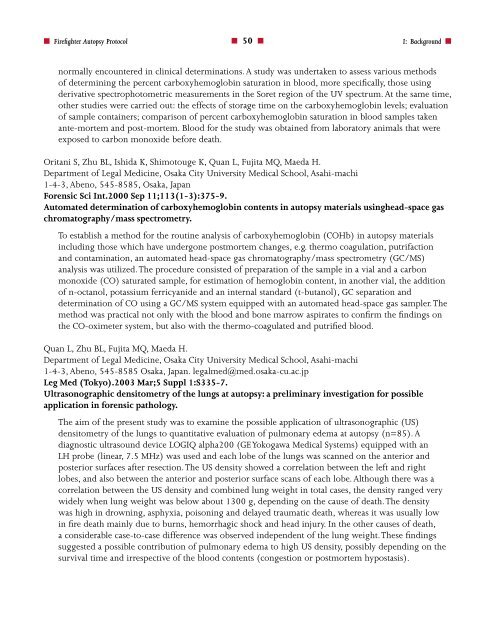Firefighter Autopsy Protocol - US Fire Administration - Federal ...
Firefighter Autopsy Protocol - US Fire Administration - Federal ...
Firefighter Autopsy Protocol - US Fire Administration - Federal ...
You also want an ePaper? Increase the reach of your titles
YUMPU automatically turns print PDFs into web optimized ePapers that Google loves.
■ <strong><strong>Fire</strong>fighter</strong> <strong>Autopsy</strong> <strong>Protocol</strong><br />
■ 50 ■<br />
I: Background ■<br />
normally encountered in clinical determinations. A study was undertaken to assess various methods<br />
of determining the percent carboxyhemoglobin saturation in blood, more specifically, those using<br />
derivative spectrophotometric measurements in the Soret region of the UV spectrum. At the same time,<br />
other studies were carried out: the effects of storage time on the carboxyhemoglobin levels; evaluation<br />
of sample containers; comparison of percent carboxyhemoglobin saturation in blood samples taken<br />
ante-mortem and post-mortem. Blood for the study was obtained from laboratory animals that were<br />
exposed to carbon monoxide before death.<br />
Oritani S, Zhu BL, Ishida K, Shimotouge K, Quan L, Fujita MQ, Maeda H.<br />
Department of Legal Medicine, Osaka City University Medical School, Asahi-machi<br />
1-4-3, Abeno, 545-8585, Osaka, Japan<br />
Forensic Sci Int.2000 Sep 11;113(1-3):375-9.<br />
Automated determination of carboxyhemoglobin contents in autopsy materials usinghead-space gas<br />
chromatography/mass spectrometry.<br />
To establish a method for the routine analysis of carboxyhemoglobin (COHb) in autopsy materials<br />
including those which have undergone postmortem changes, e.g. thermo coagulation, putrifaction<br />
and contamination, an automated head-space gas chromatography/mass spectrometry (GC/MS)<br />
analysis was utilized. The procedure consisted of preparation of the sample in a vial and a carbon<br />
monoxide (CO) saturated sample, for estimation of hemoglobin content, in another vial, the addition<br />
of n-octanol, potassium ferricyanide and an internal standard (t-butanol), GC separation and<br />
determination of CO using a GC/MS system equipped with an automated head-space gas sampler. The<br />
method was practical not only with the blood and bone marrow aspirates to confirm the findings on<br />
the CO-oximeter system, but also with the thermo-coagulated and putrified blood.<br />
Quan L, Zhu BL, Fujita MQ, Maeda H.<br />
Department of Legal Medicine, Osaka City University Medical School, Asahi-machi<br />
1-4-3, Abeno, 545-8585 Osaka, Japan. legalmed@med.osaka-cu.ac.jp<br />
Leg Med (Tokyo).2003 Mar;5 Suppl 1:S335-7.<br />
Ultrasonographic densitometry of the lungs at autopsy: a preliminary investigation for possible<br />
application in forensic pathology.<br />
The aim of the present study was to examine the possible application of ultrasonographic (<strong>US</strong>)<br />
densitometry of the lungs to quantitative evaluation of pulmonary edema at autopsy (n=85). A<br />
diagnostic ultrasound device LOGIQ alpha200 (GE Yokogawa Medical Systems) equipped with an<br />
LH probe (linear, 7.5 MHz) was used and each lobe of the lungs was scanned on the anterior and<br />
posterior surfaces after resection. The <strong>US</strong> density showed a correlation between the left and right<br />
lobes, and also between the anterior and posterior surface scans of each lobe. Although there was a<br />
correlation between the <strong>US</strong> density and combined lung weight in total cases, the density ranged very<br />
widely when lung weight was below about 1300 g, depending on the cause of death. The density<br />
was high in drowning, asphyxia, poisoning and delayed traumatic death, whereas it was usually low<br />
in fire death mainly due to burns, hemorrhagic shock and head injury. In the other causes of death,<br />
a considerable case-to-case difference was observed independent of the lung weight. These findings<br />
suggested a possible contribution of pulmonary edema to high <strong>US</strong> density, possibly depending on the<br />
survival time and irrespective of the blood contents (congestion or postmortem hypostasis).
















